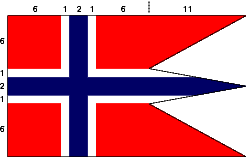Flag of Norway
|
|
The flag of Norway is red with a blue cross outlined in white that extends to the edges of the flag; the vertical part of the cross is shifted to the hoist side in the style of the Dannebrog, the flag of Denmark. The proportions of the elements of the national flag are a width of 6-1-2-1-12 and a height of 6-1-2-1-6. The proportions of the state flag is 6-1-2-1-6-11 horizontally and 6-1-2-1-6 vertically.
The red colour shall be PMS 032 U and the blue PMS 281 U in the Pantone system. This approximates to the RGB values #EF2B2D (red) and #002868 (blue).
|
|
|
| Contents |
History
Norway_flag_large_1844.png
From the 16th century onward and until 1814 Norway used the same flag as Denmark, as it was in union with that country. In 1814 independent Norway adopted the Danish flag with the Norwegian lion in the hoist. This flag was in use until 1821. Later in 1814 Norway was united with Sweden, and in 1815 a common flag for both states was introduced, the Swedish flag with a white cross on a red background in the top left corner (or canton) of the flag. This design was used for government flags and for merchant ships beyond Cape Finisterre. A distinctive Norwegian flag was designed in 1821 by Fredrik Meltzer, a member of the parliament (Storting).
Until 1838 the design was only used in Northern waters, as Norway had no treaty with the pirates of North Africa. In 1844 a union badge combining Norwegian and Swedish colors was placed at the hoist of both countries' flags. The badge was popularly called Sildesalaten from its resemblance to a herring salad. Initially, the union flag was popular in Norway, since it clearly denoted the equal status of the two united states. But as the union with Sweden became increasingly less popular, the Norwegian parliament abolished the union badge from the national, merchant and state flags in 1899. At the dissolution of the union in 1905, the badge was removed from the war flag as well. Sweden kept it in all flags until 1905.
Symbolism
Fredrik Meltzer chose a Christian cross, following the tradition of other Nordic countries (Denmark and Sweden). Red, white and blue were chosen to denote democracy, as these colours were used in the flags of more or less democratic states (The Netherlands, United Kingdom, The United States, and France). Meltzer's design also refers to the red and white Danish flag, which had been Norway's as well until 1814. The blue cross was probably a reference to the blue of the Swedish flag.
See also
External link
- Norwegian flag (http://www.fotw.net/flags/no.html) - Flags of the World
| National flags |
| List of national flags | List of national coats of arms |
de:Flagge Norwegens et:Norra lipp fr:Drapeau de la Norvège it:Bandiera norvegese he:דגל נורווגיה nl:Vlag van Noorwegen ja:ノルウェーの国旗 no:Norges flagg pt:Bandeira da Noruega sr:Застава Норвешке sv:Norges flagga zh:挪威国旗


